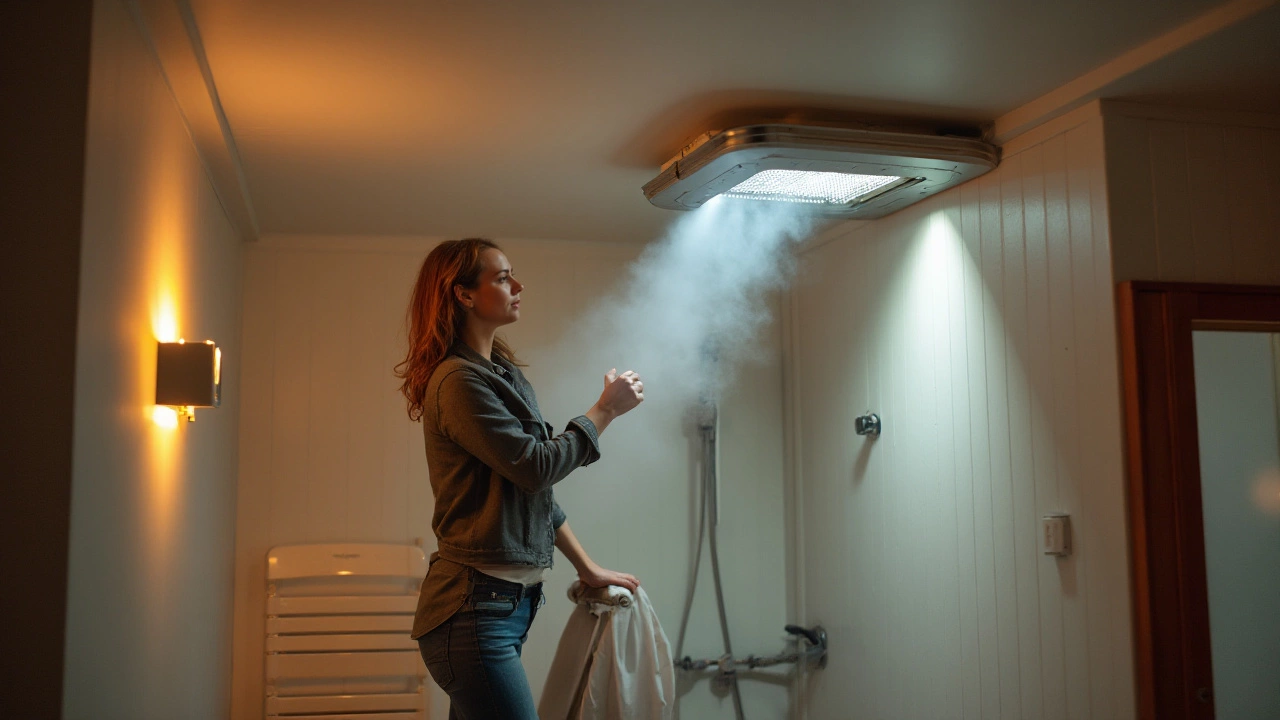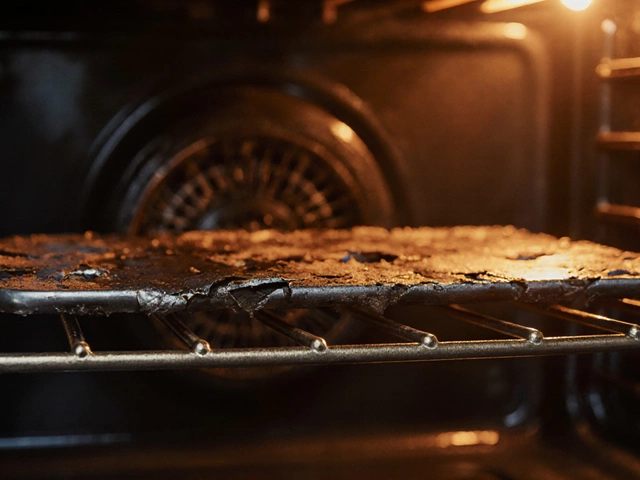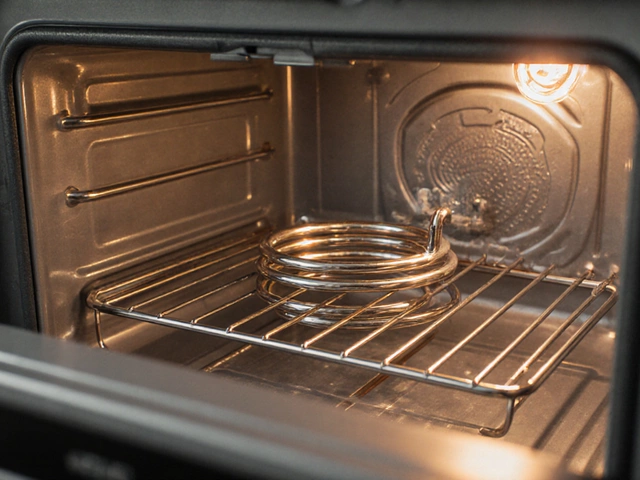Extractor fans are the unsung heroes of home ventilation, keeping moisture and odors at bay in kitchens and bathrooms. But like any other appliance, they are prone to malfunctions. When they stop working, it's not just an inconvenience; it can lead to bigger problems if not addressed promptly.
Understanding why an extractor fan might stop working is the first step towards finding a solution. It could be as simple as an electrical connection issue or as complicated as a burnt-out motor. In the paragraphs that follow, we'll delve into the common culprits behind extractor fan failures and equip you with useful troubleshooting tips and maintenance advice to ensure that these vital devices continue to operate smoothly.
- Common Causes of Extractor Fan Failure
- Signs Your Fan Needs Repair
- Step-by-Step Troubleshooting Guide
- Maintenance Tips to Prevent Future Issues
Common Causes of Extractor Fan Failure
When an extractor fan stops working, it can be traced back to a handful of common issues. One primary cause is an electrical malfunction. In many cases, the fan's motor, which is the component responsible for turning the blades, may encounter issues due to electrical surges or simply wear and tear over time. This can be especially common in older models where the wiring might not be up to modern standards. It's also not uncommon for the circuit breaker to trip if there's a short circuit, cutting power to the fan entirely.
Blockages are another frequent culprit in extractor fan repair scenarios. Dust, grease, and debris can accumulate over time, clogging the vents and restricting airflow. This can cause the fan to work harder than it should, leading to overheating and, eventually, failure. Regular cleaning can help prevent this, but in busy households, it might still be necessary to periodically dismantle the fan for a deeper clean. In fact, some experts recommend cleaning the extractor fan at least every six months to maintain optimal performance.
Loose or broken fan blades can also spell trouble for your extractor fan. If you notice a rattling or unusual noise when the fan is in operation, it could indicate that the blades are not properly attached. This is something that can often be fixed with a simple screwdriver to tighten any loose screws, though replacing broken blades will sometimes be necessary. It's worth mentioning that each manufacturer's design can vary significantly, so always refer to the owner's manual when attempting repairs.
"Maintenance is the key to keeping extractor fans - and other appliances - in peak condition," says Mark Johnson, a home appliance expert with over 20 years of experience.One less obvious issue is damage to the fan’s control switch or speed setting mechanism. These components might be thought of as just switches, but they can wear out over time, especially if they are used frequently. A fan that doesn't respond to speed changes or won't turn off could have a faulty control switch that needs replacing. This issue typically requires a bit more technical know-how and a visit to your local hardware store for a replacement part.
Finally, installation errors can also lead to failure. Factors like improper angles or insufficient space for ventilation can put unnecessary stress on the fan, reducing its lifespan. Always ensure that the fan is installed according to the manufacturer's guidelines. Improper installation not only hampers the effectiveness of ventilation but can also void warranties, leaving homeowners liable for replacement costs. Taking care to hire qualified professionals when installing these devices can save significant headaches down the line.

Signs Your Fan Needs Repair
Extractor fans play a vital role in ensuring good ventilation within your home, especially in areas such as the kitchen and bathroom. However, when they start developing issues, your living space can quickly become uncomfortable. Identifying symptoms early can help prevent further damage and maintain your extractor fan repair costs. One of the most obvious signs is unusual noises during operation. If you're hearing grinding, squealing, or humming that wasn't there before, it's worth investigating as these sounds often indicate mechanical issues like a worn-out bearing or motor impairment. Sometimes, obstructions caused by dust accumulation or small objects lodging into the fan blades can also create these noises.
Another red flag that you might need to check is a noticeable drop in performance. If your unit isn't effectively removing steam, odors, or smoke as it used to, it could be due to clogged filters, impaired electrical connections, or a failing motor. Slow fan speed, even after cleaning, often points to deeper mechanical or electrical faults. Regularly monitoring the fan's effectiveness can save you from more extensive repairs later on. Furthermore, if the extractor fan fails to turn on or suddenly stops mid-operation, you're likely dealing with an electrical problem. Broken switches, tripped circuit breakers, or faulty internal wiring are common causes and should be handled by a professional to avoid safety hazards.
Visible wear and tear such as cracks on the fan blades or housing or visible rust on motor components can also signal that your fan is due for maintenance. Since the fan's environment is often humid, parts like the casing and blades might corrode over time, which could impair its efficiency. In these cases, replacement parts or a unit upgrade might be necessary to continue maintaining suitable air quality. Regular inspection of your fan can illuminate such issues before they escalate into more significant problems.
According to the Environmental Protection Agency, addressing ventilation problems promptly can significantly enhance indoor air quality, reducing the risk of respiratory issues and improving overall comfort in living spaces.
If you're keeping an eye on your energy usage, an unexpected spike can also point toward a malfunctioning extractor fan. Struggling fans tend to consume more power to operate at their previous efficiency levels. Don't hesitate to pay attention to even slight changes in your electricity bills, as these could indicate that your fan is overworking due to underlying issues. Conducting routine energy audits might quickly help uncover whether your ventilation unit is operating efficiently.
A step often overlooked is regular maintenance checks. Many homeowners either forget or don't realize that periodic cleaning and inspection can prevent signs of damage from occurring. For instance, clogged or dusty filters reduce airflow, placing unnecessary strain on the fan's motor, potentially leading to a breakdown over time. By scheduling regular check-ups, you can extend the longevity of your fan and maintain good home ventilation. Including a simple checklist such as looking out for noise, performance, wear and tear, and energy consumption can simplify the task.

Step-by-Step Troubleshooting Guide
When embarking on the task of diagnosing why your extractor fan isn't spinning merrily, it's crucial to proceed methodically. Once these seemingly enigmatic contraptions halt, the reasons behind it can be varied. Before diving deep into electrical components, ensure giving a look at the most straightforward solutions. Begin by checking if the power supply is functional. Verify the circuit breaker and ensure it hasn’t tripped. A power interruption is one of the most common causes of an extractor not working. If the fan has a switch, make sure it's correctly turned on.
If your fan troubleshooting doesn't yield results from checking the power, it's time to consider a deeper dive. Have you heard odd noises? Odd sounds often indicate an obstruction or debris within the fan mechanism. Use a flashlight to peer into the vent to check for visible obstructions. If you spot something, carefully remove it to avoid damaging the fan blades. They rely on free movement, and any hindrance can stop them cold.
Moving to more technical investigation involves inspecting the wiring. This step demands some degree of caution; after all, safety is paramount. It can be helpful to have a continuity tester or multimeter handy to check that everything is as it should be. Sometimes, a loose connection is all it takes to disrupt your ventilation issues. These testing devices can tell you if the current is flowing through as expected or if there's a discontinuity. In such cases, it might be wise to consult or hire a professional electrician, as mentioned by the National Electrical Contractors Association:
"Engaging professionals can significantly reduce the risks associated with amateur electrical repairs."
Once you're certain electricity is flowing without a hitch, it's time to take a look at the motor. After years of faithful service, motors can burn out. This is sometimes accompanied by an acrid burning smell. Examine the motor for any signs of wear or burnout, like discoloration. If the motor is indeed kaput, replacing it might just bring your extractor fan back to life.
Lastly, you might want to inspect the fan's separate components. Many models come with replaceable parts like filters, which can become clogged over time, limiting airflow efficiency. Examine these filters and clean or replace them as needed. A clean filter ensures that your fan maintains its optimal performance, steering clear of future extractor fan repair needs. Regular maintenance checks are a sure-fire way of breathing new life into your extractor.

Maintenance Tips to Prevent Future Issues
Regular maintenance of an extractor fan is key to warding off unexpected breakdowns. To keep your device in top condition, it’s important to start with a basic cleaning routine. Fans accumulate dust and grime over time, which can hinder their performance. By making it a habit to clean the fan grill at least every few months, you can avoid blockages that could lead to overheating or ineffective airflow. Using a damp cloth and a mild detergent, gently wipe the blades and the surrounding parts. An extra tip: lightly vacuuming the motor area can remove any hidden debris, just be careful to switch off the power first.
Besides cleaning, inspecting the mechanical parts and wiring can help head off any brewing trouble. Periodically, it’s advisable to check the screws and bolts that hold the parts together. A loosely fastened component can create vibrations or noise and eventually lead to damage. If you notice any unusual sounds while the fan is running, it’s time to investigate. Tightening or replacing a loose screw might just be the fix needed. As for the electrical components, a quick visual inspection of the wires can reveal wear or fraying that could potentially cause electrical failures. If you feel uneasy about engaging with electrical parts, it might be best to consult a professional.
Keeping moisture away from the fan extends its life. While it might sound counterintuitive because fans often operate in wet areas, excess moisture can be damaging. Installing a moisture-resistant fan, or placing a dehumidifier in a very damp bathroom or kitchen could solve this problem. Monitoring and planning for moisture levels can help prevent rust and corrosion in different fan parts. Did you know that the build-up of condensation is one of the most common reasons why an extractor fan might get damaged in a bathroom environment?
"Regular maintenance not only increases the efficiency of home appliances but significantly extends their lifespan," says John Smith, a well-respected home renovation expert.
For tech-savvy individuals, considering a smart upgrade might be appealing. Modern extractor fans often come with humidity sensors and automatic shutoff features, taking much of the guesswork out of fan maintenance. They can adjust fan speed or switch off when optimal air quality is achieved, leading to energy savings and prolonged fan life. Installation might require an upfront investment but it could pay off in terms of saved energy and hassle in the long run. Table 1 shows comparative benefits of traditional vs. smart fans:
| Feature | Traditional Fan | Smart Fan |
|---|---|---|
| Energy Efficiency | Moderate | High with sensors |
| Maintenance Needs | Regular manual | Reduced with automation |
| Lifespan | Depend on use | Potentially longer |
Finally, consult the manual, which often contains great advice from the manufacturer. Proper use and care instructions specific to your fan model can prevent mishandling. Much like a pet or a plant, caring for an extractor fan requires attention over its lifespan to ensure it operates flawlessly, keeping your home’s air fresh and free from unwanted odors or damp.





